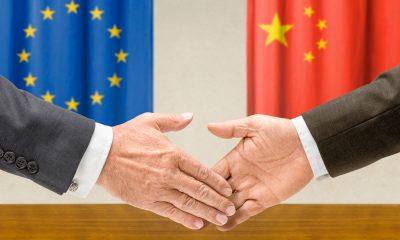Foreign
Turkey probes social media plea for international aid to combat fires

Turkish prosecutors on Thursday launched an investigation into a social media campaign seeking international support to help combat the wildfires that continued to burn in the south of the country.
The public prosecutor’s office in Ankara is investigating social media accounts on suspicion of “generating fear and panic” and inciting hatred among public, according to state news agency Anadolu.
The accusations also included insulting the state and the president.
In the past, President Recep Tayyip Erdogan’s government had temporarily banned social media platforms such as Twitter and YouTube on similar allegations.
Amid growing anger and despair over government’s response to the devastating fires, Twitter and Instagram users issued calls for aid from the international community using the hashtag #HelpTurkey during the past week.
As Turkey battles the worst fires seen in more than a decade, Erdogan again denied the country had failed to introduce adequate preparatory measures, in comments to broadcaster A Haber late on Wednesday.
He accused the opposition of spreading “a terror of lies.”
The opposition accused the government of leaving state-owned firefighter planes idle at an airport in Ankara.
Erdogan said 20 firefighter planes and 51 helicopters had been sent to help contain the blazes. Croatia, Spain, Ukraine, Russia, Iran and Azerbaijan had all sent fire-fighting planes.
The wildfires in Turkey have been raging for nearly 10 days, particularly near Antalya and Mugla, popular tourist destinations.
Meanwhile emergency crews have brought a fire under control in Milas, western Turkey, which had reached a coal-fired power plant during the night.
Several neighbourhoods in the region were evacuated during the night, and the navy helped some residents to safety across the sea. (dpa/NAN) (www.nannews.ng)
Foreign
China-EU economic, trade cooperation brings greater stability to global economy

By Guo Ziyun, Yu Limin, Niu Ruifei, People’s Daily
This year 2025 marks the 50th anniversary of the establishment of diplomatic relations between China and the European Union (EU). As the world’s second and third largest economies, China and the EU collectively account for over one third of the global economy and more than a quarter of global trade. Both sides are advocates of economic globalization and trade liberalization, and firm defenders and supporters of the World Trade Organization.
Over the past five decades, the two sides have continued to deepen their economic and trade cooperation, benefiting the two peoples and the world at large. As the global economy faces mounting instability and uncertainty, closer communication and cooperation between China and the EU can contribute to open and free trade and investment, ensure stable and unimpededglobal industrial and supply chains, and inject greater stability and certainty into the world economy.
In the western Polish city of Slubice, the rhythmic hum of conveyor belts fills a warehouse run by MBB Logistics, where workersmethodically sort and dispatch packages destined for consumers across Poland and Germany — usually within 24 hours.
This warehouse is part of a growing logistics footprint made possible by the China-Europe freight service. Over the past several years, MBB Logistics has expanded into eight warehouses in the region, covering 160,000 square meters and handling a wide range of goods including electronics, mechanical parts, household supplies, and hardware. Sourced from nearly 300 Chinese e-commerce partners, these goods form a bridge between thousands of Chinese manufacturers and the vast European market.
Julio Rios, a Spanish expert on China, observed that the China-Europe freight service addresses the needs of both China and Europe in a complementary and innovative way. He views the freight service as a catalyst for unleashing the economic and trade cooperation potential of countries along the route.
As morning light pierced the mist and spread across the vast Hungarian plains, rows of sand martin nests dotted the rocky embankment near the tracks of the Budapest-Belgrade railway– home to hundreds of the birds.During the railway’s construction, Chinese builders went to great lengths to protect the birds’ habitat, which has since become a cherished story in the local community.
The Hungary-Serbia railway is a vivid example of China and the EU jointly building green Belt and Road.
In Greece, Chinese enterprises are actively promoting green and digital transformation at the Piraeus port, striving to transform it into a sustainable, efficient, and intelligent port.
In Malta, the Delimara 3 power station, upgraded by a Chinese company, now emits significantly less pollution and carbon than EU environmental standards require, shifting from a heavy polluter to a model of green innovation.
In Serbia, the Chinese-built Kostolac Power Plant is converting ash and slag into exportable concrete materials, reducing dust emissions while generating revenue.
These green projects and technologies are propelling Europe’s green transition and injecting new momentum into regional economic development.
Fabian Zuleeg, chief economist at the European Policy Center, sees vast potential in China-EU trade and investment cooperation, especially in tackling climate change. With shared goals and a growing alignment on green priorities, he noted, both sides recognize the scale of business opportunities ahead.
European companies express growing confidence in the Chinese market through tangible investments. France-based cosmetic giantL’Oreal has launched two new investment funds in China. German industrial giant Siemens opened its first industrial ecosystem hub in western China in Chengdu, Sichuan province. Danfoss, a global refrigeration industry giant headquartered in Danmark, inaugurated its first carbon-neutral factory in China, located in Nanjing, Jiangsu province. According to China’s Ministry of Commerce, actual investment from the EU to China rose by 11.7 percent in the first quarter of this year.
China-EU investment cooperation continues to expand, particularly in areas such as new energy, green technology, and smart manufacturing.
Greece’sPiraeus Port Authority S.A., operated by a Chinese company, posted record-high revenues and profits in 2024. In the first quarter, Chinese electric vehicle battery giant CATL saw strong year-on-year growth in power battery sales in the European market, with its factory in Thuringia, Germany achieving profitability. Meanwhile, Chinese automaker Chery Automobileand Spain’s Ebro-EV Motors signed a pact to develop new electric vehicles through a joint venture, breathing new life into a cherished local brand.
Bernard Dewit, chairman of the Belgian-Chinese Chamber of Commerce, noted that Chinese and European companies continue to demonstrate innovation and resilience. In anincreasingly complex international environment, he said, they are forging win-win partnerships and opening up broad development prospects.
Foreign
Traditional Chinese medicine bridges hearts between China, Russia

By Xiao Xinxin, People’s Daily
“The new building of Moscow State University, perched on Lenin Hills, is being adorned with masterpieces by Soviet sculptors, painters, and decorative artists… Among them are exquisite portraits of the great Chinese scientist Zu Chongzhi and herbalist Li Shizhen,” read the front page of Pravda on March 28, 1953.
“This reflects the profound respect of the Soviet people for the great and friendly Chinese people, whose ancient civilization boasts a brilliant cultural heritage,” the article continued.
Founded in 1755, Moscow State University completed its iconic main building in September 1953. Today, visitors entering the main auditorium pass through a corridor where a decorative frieze beneath the ceiling displays mosaic portraits of some of the world’s most renowned scientists, rendered in vibrant marble. Among them are Zu Chongzhi, the mathematician, astronomer, and scientist of China’sSouthern and Northern Dynasties (420-589), and Li Shizhen, the acclaimed pharmacologist in China’sMing Dynasty (1368-1644).
While decades have passed, the traditional Chinese medicine (TCM) and TCM culture that Li represents continue to flourish. In today’s Russia, TCM is steadily gaining ground, with a growing number of people turning to its treatments.
At the St. Petersburg TCM Center established by Beijing University of Chinese Medicine, Svetlana, a local resident,was receiving therapy. She has long suffered from dizziness, headaches, fatigue, and persistent pain in her shoulders and arms. On her family’s recommendation, she visited the center, where doctors applied cupping therapy, acupuncture, and moxibustion.
“The results were remarkable! My symptoms have eased significantly, and I feel much more at ease,” she said. “I now truly understand the value of TCM.”
Opened in July 2016, the St. Petersburg TCM Center was the first TCM hospital in Russia to receive legal accreditation under local medical regulations. According to Liu Qingguo, head of the center, it has treated over 4,000 patients and provided more than 10,000 treatment sessions. Treatments such as scalp acupuncture, fire needling, heat-sensitive moxibustion, and therapeutic massage have offered relief to many suffering from chronic ailments.
The center has also forged partnerships with Russian medical research institutions and regularly hosts free consultations, public lectures, and joint clinics to broaden understanding of TCM within the local community.
“With growing interest in TCM among Russians, we are expanding training programs for practitioners,” said Huang Guorong, president of the Russian Association of Specialists of Traditional Chinese Medicine. Founded in 2018, the association has played an increasingly active role in TCM education. In 2024 alone, its international school of oriental medicine in Moscow conducted nearly 100 specialized training sessions, teaching over 7,000 trainees from Russia and neighboring countries. Many graduates have since entered the TCM field professionally.
In recent years, medical tourism centered on TCM has flourished along the China-Russia border. A increasing number of Russian tourists are traveling to northeast China in search of TCM treatments. In cities like Heihe and Suifenhe, both in northeast China’s Heilongjiang province, Russian “medical tour groups” have become a familiar presence. Meanwhile, the Wudalianchi scenic area in Heihe, renowned for its volcanic landscape and mineral-rich cold springs, welcomes nearly 10,000 Russian visitors annually for therapeutic retreats.
Fedot Tumusov, first deputy chairman of the State Duma Committee on Health Protection of the Federal Assembly of the Russian Federation, noted that China and Russia are deepening heathcare cooperation, and both doctors and patients in Russia are showing greater openness toward TCM.
“We look forward to continued collaboration that fosters mutual learning and promotes the deeper integration of TCM into Russia’s healthcare system to benefit more people,” he added.
Foreign
To work toward even brighter future for China-EU relations

By He Yin, People’s Daily
On May 6, Chinese President Xi Jinping exchanged congratulations with European CouncilPresident Antonio Costa and European Commission President Ursula von der Leyen over the 50th anniversary of diplomatic relations between China and the European Union (EU).
Xi noted that since the establishment of their diplomatic ties 50 years ago, China and the EU have maintained close exchanges across various levels and sectors, saying that the accomplishments of their dialogue and cooperation are fruitful, cultural and people-to-people exchanges vibrant, and multilateral coordination productive.
He added that China-EU relations have become one of the most influential bilateral relations in the world, contributing greatly to enhancing the well-being of their people, and promoting world peace and development.
In this half-century-long relationship between China and the EU, the most valuable asset is mutual respect, the most powerful impetus is mutual benefit, the greatest unifying consensus is multilateralism, and the most accurate characterization is partnership.
China always views its relations with the EU from a strategic and long-term perspective, and regards Europe as an important dimension in its major-country diplomacy with Chinese characteristics and an important partner on its path toward Chinese modernization.
In March 2014, Xi paid a historic visit to the EU headquarters and proposed that the two sides should jointly forge China-EU partnerships for peace, growth, reform and civilization, enriching the strategic substance of the China-EU comprehensive strategic partnership.
Since the beginning of this year, China and the EU have maintained frequenthigh-level interactions, sending a strong signal to the international community that they are both committed to multilateralism and free trade. Amid mounting global uncertainty, the two sides continue to serve as anchors of stability and constructive forces.
China and the EU enjoy complementary strengths and mutual benefits in economic and trade cooperation, forming a robust relationship of economic symbiosis.
In the past five decades, China-EU trade has expanded from $2.4 billion to $785.8 billion in 2024. Investment has increased from almost zero to close to $260 billion. China-Europe Railway Express has run more than 100,000 cargo trips and become a golden passage connecting Asia and Europe.
According to China’s General Administration of Customs, in the first quarter of this year, trade between the two sides reached 1.3 trillion yuan ($179.29), which translates to over 10 million yuan in trade every minute.
China’s pursuit of high-quality development and high-level opening up is creating new opportunities for bilateral cooperation.
Recently, European political and business leaders have actively visited China to attend events such as the China Development Forum and the Boao Forum for Asia Annual Conference. European multinationals have launched new products at Chinese expos and deepened their engagement with the Chinese market.
At the same time, Chinese business delegations have also held trade and investment matchmaking events in several European countries. The sustained two-way economic and trade engagement reflects the strong internal momentum and bright prospects of China-EU relations.
As China and the EU continue to act as partners for mutual success, their cooperation will not only support each other’s development but also provide stronger momentum for the stability of global industrial and supply chains as well as global development.
A healthy and stable China-EU relationship not only promotes mutual achievements, but also illuminates the world. From jointly promoting the conclusion of the Paris Agreement, to enhancing cooperation on biodiversity conservation, and advancing collaboration on global AI governance, China and the EU have engaged in effective multilateral coordination and cooperation in many fields, laying a solid foundation for their partnership in global governance.
Today, as unilateralism, protectionism, hegemonism, and power politics pose severe threats to international rules and order, deepening China-EU cooperation takes on even greater practical significance. Together, China and the EU account for over one third of the global economy and more than a quarter of global trade. As long as the two sides choose dialogue and cooperation, camps of confrontation will not emerge, and as long as they opt for openness and mutual benefits, the trend of economic globalization will not experience a fundamental reversal.
As two major forces promotingmulti-polarization, two major markets supporting globalization, and two major civilizations advocating diversity, China and the EU should remain committed to multilateralism, uphold fairness and justice, oppose unilateralism and bullying, join forces in addressing global challenges, and jointly build an equitable and orderly multipolar world and an inclusive economic globalization, so as to make greater contributions to world peace, stability, development and prosperity.
The history of China-EU relations demonstrates that as long as both sides uphold mutual respect, treat each other as equals, and engage in candid dialogue, they can advance cooperation and make significant achievements.
China is willing to work with the EU to uphold the comprehensive strategic partnership, make bilateral relations more stable, constructive, reciprocal and global, better benefit the two peoples and the international community, and work toward an even brighter future for China-EU relations.
-

 News4 hours ago
News4 hours agoCBIAMEC Congratulates NCDC Board Member, Solomon Adodo
-

 Entertainment4 hours ago
Entertainment4 hours agoBarry Showkey Set to Drop New Single “ROBOROBO” on May 15
-
News4 hours ago
Saraki committee: PDP on the path to resurgence- Utaan
-

 News6 hours ago
News6 hours agoSaraki committee: pdp on the path to resurgence- Utaan
-

 Foreign44 mins ago
Foreign44 mins agoAt Moscow Zoo, a panda family charms crowds and symbolizes China-Russia friendship
-

 Foreign31 mins ago
Foreign31 mins agoTo work toward even brighter future for China-EU relations
-

 Foreign20 mins ago
Foreign20 mins agoTraditional Chinese medicine bridges hearts between China, Russia









